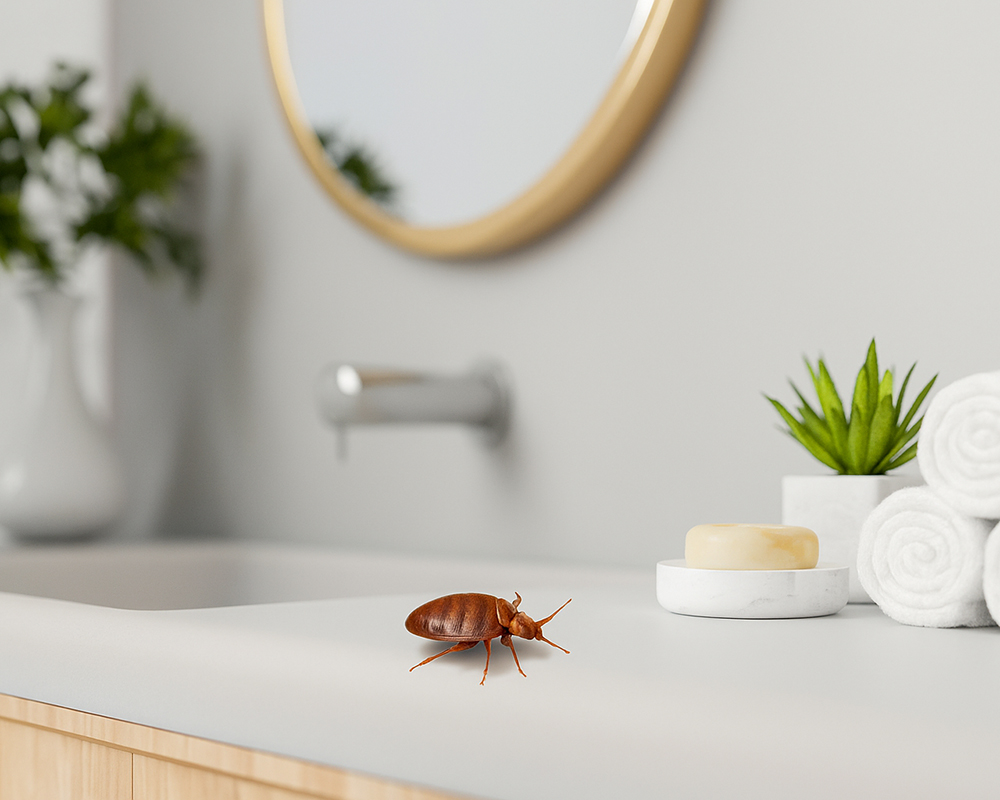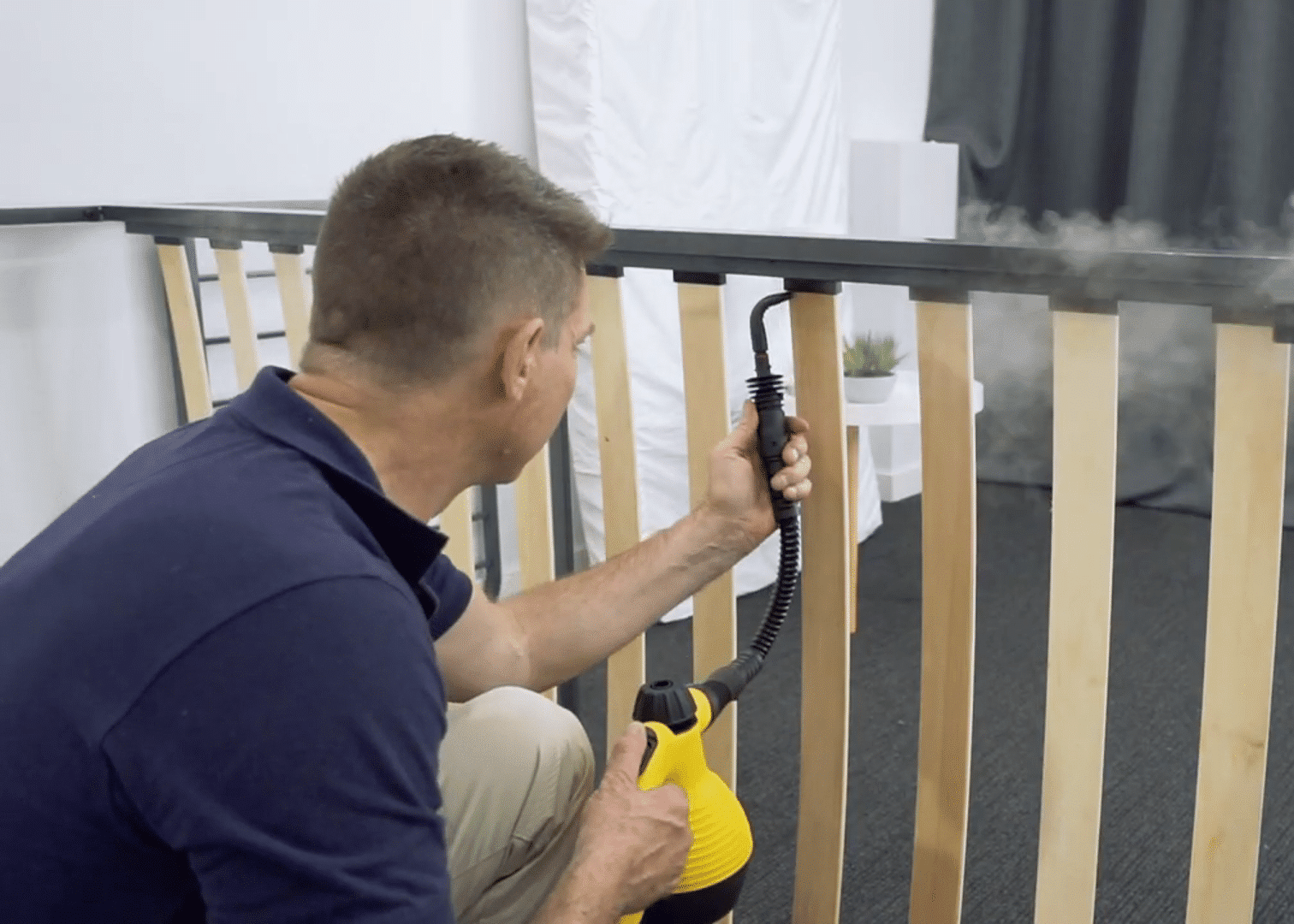
In the article
Last Updated on 24/06/2025 by Tony Abrahams
Bed bugs can live in the bathroom for a short time, but they do not thrive or survive there. Bathrooms simply do not provide the conditions bed bugs need to survive, feed, or reproduce. If you’ve spotted one crawling across your bathroom floor, chances are it came from somewhere else, most likely your bedroom.
Still, that single sighting is a big warning sign.
Do Bed Bugs Live in Bathrooms?

Bed Bugs Cant Survive in the Bathroom Long Term
No. Bed bugs are not designed to live in bathrooms. While they might end up there occasionally, it is not a place where they settle in or build a colony.
Why?
Because bed bugs hate water, so bathrooms are the opposite of what bed bugs are looking for. They prefer warm, dry spaces with plenty of soft material and access to a sleeping human who lies still for hours. That means beds, mattresses, ensemble bases, couches, or even carpeted areas.
Bathrooms, on the other hand, are usually:
- Cool or tiled with hard surfaces
- Exposed to bright lights and constant cleaning
- Lacking in fabrics or soft hiding places
- Wet and humid, which makes it hard for bed bugs to move around
But the biggest reason? Bed bugs cannot feed on wet skin. After a shower, your body is damp and slippery, and your blood vessels are not as accessible. Bed bugs rely on still, dry skin to pierce and draw blood. So a bathroom is not just uncomfortable for them. It is actually useless. There is no food source there.
If you have seen a bed bug in the bathroom, it is likely just one that was disturbed or is looking for a new hiding place. It is not evidence that your bathroom is infested.
Where Would They Hide If They Ended Up There?
If a bed bug did somehow end up in the bathroom, it would look for any narrow gap or hidden area to tuck itself away. They are experts at squeezing into tiny spaces.
Possible hiding spots include:
- Behind or beneath the vanity
- In the gap where the floor meets the skirting board
- Under loose tiles or cracked grout
- Around the base of the toilet or shower pipes
- In or under bath mats, towels, or laundry piles
Even in those places, the environment is too exposed, too wet, and too bright for long-term survival. Bed bugs found in bathrooms are usually there temporarily, either as a result of being displaced or because they hitched a ride on something.
Why Would a Bed Bug Be in My Bathroom?

Towels from the bed can spread bed bugs to the bathroom or laundry
Here are some common scenarios:
- It travelled in with towels or clothes. Bed bugs often cling to fabric. If you brought bedding, pyjamas, or dirty clothes into the bathroom, one may have come with them.
- It was flushed out by cleaning. If you recently vacuumed, steamed, or treated your bed or furniture, you may have driven some bugs out of their usual hiding spots.
- It is migrating. Bed bugs move toward warmth, body heat, and carbon dioxide. If they cannot find food in one room, they might start exploring new areas.
In every case, the bathroom sighting is not the main problem. It is the tip of the iceberg. The infestation almost always starts in or around the bed.
Bed Bug Bites in Australia: How to Find, Treat and Prevent Bed Bugs Fast
Can Bed Bugs Travel Through Drains or Pipes?
This is a common fear, but the answer is no.
Bed bugs cannot swim, they do not nest in drains, and they cannot travel through plumbing systems. Their legs are not built for climbing smooth metal or porcelain, and they cannot survive being submerged in water.
However, in apartment buildings, they can move between units. That happens through vents, cracks in walls, around plumbing fixtures, or behind skirting boards. It is not about the pipes themselves, but rather the small gaps around them. That is how they can travel room to room or even apartment to apartment.
So if you are in a multi-unit building and spot a bed bug in the bathroom, it might be moving from a neighbour’s infested unit to yours. Again, this points to a bigger issue.
What Should You Do If You See One in the Bathroom?
You do not need to spray your bathroom or tear it apart. Instead, you need to assume there are more bugs elsewhere and focus on the most likely source: your bedroom.
A bathroom sighting tells you the bugs are on the move. The infestation is growing. Now is the time to act fast and smart.
How to Kill Every Bed Bug Fast and For Good

Use Steam To Dispose Of Bed Bugs Instantly
The fastest, cheapest, and most effective way to eliminate bed bugs is with the Bed Bug Isolation Method. This method gives you instant protection starting the same night and long-term prevention without needing to constantly reapply chemicals or call in pest control.
Step-by-step: How It Works
- Use mattress and base covers
Fit both your mattress and ensemble base with tightly woven bed bug–proof covers. These trap any bugs already inside and stop new ones from getting in. It turns your bed into a sealed zone. - Kill instantly with steam
Use a handheld steamer to treat the bed frame or ensemble base. Steam kills bed bugs and their eggs on contact. You do not need to use steam anywhere else. Just focus on the bed frame. - Set up bed leg traps filled with Diatomaceous Earth
Diatomaceous Earth (DE) is a natural, non-toxic powder that kills bed bugs by damaging their outer shell. Lightly dust it inside special bed leg traps. When bugs try to climb up the bed for a blood meal, they walk through the DE and die within days. This gives you long-term, passive protection. - Isolate the bed
Move the bed at least 30 centimetres away from walls, furniture, and curtains. Make sure nothing touches the floor—not sheets, not blankets, nothing. This turns your bed into an island. The only way for bugs to reach you is via the legs, and all four legs are protected with lethal traps.
You can sleep in your bed the same night. No chemicals. No downtime. No guesswork. Over the next few weeks, every bed bug in the room will try to reach you and will die in the process.
Isolation Method Video For An Ensemble Bed
Isolation Method Video For Beds with Slats
If you have enjoyed our blog, Can Bed Bugs Live in the Bathroom?, then you might like to read about, Where Do Bed Bugs Hide?
Frequently Asked Questions: Can Bed Bugs Live in the Bathroom?
- If I find a bed bug in my bathroom, does that mean my whole house is infested?
Not necessarily, but it does suggest there’s an active infestation somewhere nearby—most likely your bedroom. Bed bugs rarely live in bathrooms, so if one shows up there, it’s usually a sign they’ve spread from their main hiding spot. - Can bed bugs come up through the shower drain or sink pipes?
No. Bed bugs can’t survive in water, don’t live in drains, and can’t crawl up through plumbing. They prefer dry, warm environments and need access to human blood. If you find one near a drain, it likely arrived there by accident. - Should I treat my bathroom if I see a bed bug there?
No. Focus your treatment on the bedroom, not the bathroom. Bed bugs in the bathroom are usually displaced or passing through. Using the Isolation Method in the bedroom is the fastest and most effective way to eliminate the entire infestation.
Final Thoughts: Can Bed Bugs Live in the Bathroom?
So, can bed bugs live in the bathroom? The short answer is no. They might end up there, but they cannot feed, hide properly, or survive long-term.
But seeing one there means the infestation has started to spread. It is a signal that they are looking for new ground because they are already comfortable somewhere else—usually your bed.
The best next step is not panic. It is action. Use the Isolation Method to reclaim your bed, protect your family, and kill every bed bug in the room without turning your house upside down.
Sources: Can Bed Bugs Live in the Bathroom?
Environmental Protection Agency (EPA) – Bed Bug Biology
https://www.epa.gov/bedbugs/bed-bug-biology
Explains how bed bugs behave, where they hide, and why they prefer areas near sleeping hosts over places like bathrooms.
University of Minnesota Extension – Let’s Beat the Bed Bug
https://extension.umn.edu/bed-bugs/bed-bug-control-home
Details where bed bugs typically live, their movement patterns, and how infestations spread within a home.
National Pesticide Information Center – Bed Bugs FAQ
http://npic.orst.edu/pest/bedbug.html
Covers myths and facts about bed bug habits, including the misconception that they live in drains or bathrooms.



Leave a Reply